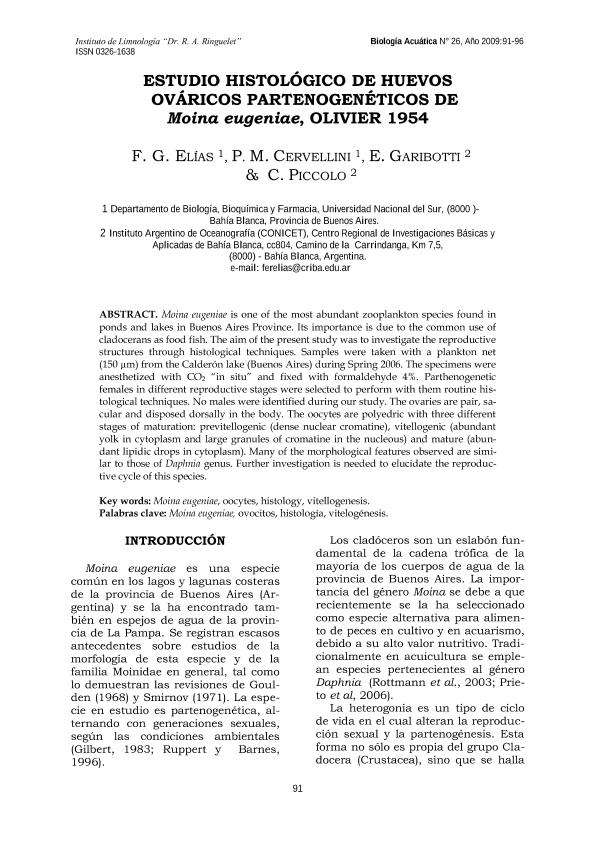Artículo
Estudio histológico de huevos ováricos partenogenéticos de Moina eugeniae, Olivier 1954
Elias, Fernanda Gabriela; Cervellini, Patricia Marta; Garibotti, Emilio Javier ; Piccolo, Maria Cintia
; Piccolo, Maria Cintia
 ; Piccolo, Maria Cintia
; Piccolo, Maria Cintia
Fecha de publicación:
03/2009
Editorial:
Instituto de Limnología “Dr. R. A. Ringuelet”
Revista:
Biología Acuática
ISSN:
0326-1638
Idioma:
Español
Tipo de recurso:
Artículo publicado
Clasificación temática:
Resumen
Moina eugeniae is one of the most abundant zooplankton species found in ponds and lakes in Buenos Aires Province. Its importance is due to the common use of cladocerans as food f ish. The aim of the present study was to investigate the reproductive structures through histological techniques. Samples were taken with a plankton net (150 μm) from the Calderón lake (Buenos Aires) during Spring 2006. The specimens were anesthetized with CO 2 “in situ” and fixed with formaldehyde 4%. Parthenogenetic females in different reproductive stages were selected to perform with them routine hi s- tological techniques. No males were identified during our study. The ovaries are pair, s a- cular a nd disposed dorsally in the body. The oocytes are polyedric with three different stages of maturation: previtellogenic (dense nuclear cromatine), vitellogenic (abundant yolk in cytoplasm and large granules of cromatine in the nucleous) and mature (abundant lipidic drops in cytoplasm). Many of the morphological features observed are similar to those of Daphnia genus. Further investigation is needed to elucidate the reproductive cycle of this species.
Palabras clave:
Moina Eugeniae
,
Ovocitos
,
Histología
,
Vitelogénesis
Archivos asociados
Licencia
Identificadores
Colecciones
Articulos(IADO)
Articulos de INST.ARG.DE OCEANOGRAFIA (I)
Articulos de INST.ARG.DE OCEANOGRAFIA (I)
Citación
Elias, Fernanda Gabriela; Cervellini, Patricia Marta; Garibotti, Emilio Javier; Piccolo, Maria Cintia; Estudio histológico de huevos ováricos partenogenéticos de Moina eugeniae, Olivier 1954; Instituto de Limnología “Dr. R. A. Ringuelet”; Biología Acuática; 26; 3-2009; 91-96
Compartir



